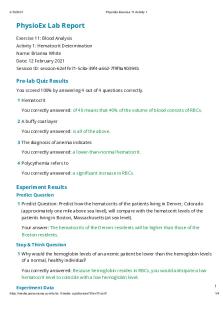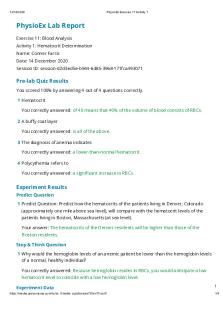Physio Ex Exercise 1 Activity 1 PDF

| Title | Physio Ex Exercise 1 Activity 1 |
|---|---|
| Author | Kelly Isidro |
| Course | Physiology |
| Institution | Monterey Peninsula College |
| Pages | 4 |
| File Size | 136.5 KB |
| File Type | |
| Total Downloads | 37 |
| Total Views | 129 |
Summary
PEX exercise 1 activity 1...
Description
9/18/2020
PhysioEx Exercise 1 Activity 1
PhysioEx Lab Report Exercise 1: Cell Transport Mechanisms and Permeability Activity 1: Simulating Dialysis (Simple Diffusion) Name: Kelly Isidro Date: 18 September 2020 Session ID: session-4604ab7f-3c43-aee5-d7e9-4191050adc35
Pre-lab Quiz Results You scored 100% by answering 3 out of 3 questions correctly. 1 The driving force for diffusion is You correctly answered: the kinetic energy of the molecules in motion. 2 In diffusion, molecules move You correctly answered: from high concentration to low concentration. 3 Which of the following dialysis membranes has the largest pore size? You correctly answered: 200 MWCO.
Experiment Results Predict Questions 1 Predict Question 1: The molecular weight of urea is 60.07. Do you think urea will diffuse through the 20 MWCO membrane? Your answer: Yes, but very slowly. 2 Predict Question 2: Recall that glucose is a monosaccharide, albumin is a protein with 607 amino acids, and the average molecular weight of a single amino acid is 135 g/mol. Which of the following will be able to diffuse through the 200 MWCO membrane? Your answer: glucose only. Stop & Think Questions 1 The reason sodium chloride didn't diffuse left to right is that You correctly answered: the membrane pore size was too small. https://media.pearsoncmg.com/bc/bc 0media ap/physioex/10/ex1/act1/
1/4
9/18/2020
PhysioEx Exercise 1 Activity 1
2 Glucose is a six-carbon sugar. Albumin is a protein with 607 amino acids. The average molecular weight of a single amino acid is 135 g/mol. There is no reason to run these solutes at the 20 MWCO because You correctly answered: glucose and albumin are both too large to pass. 3 The rate of diffusion for urea You correctly answered: is slower than that for sodium because urea is a larger molecule. Experiment Data Solute
MWCO
Left Solute (mM)
Right Solute (mM)
Average Diffusion (mM/sec)
Na + Cl -
20
9.00
0.00
0.0000
Urea
20
0.00
0.00
0.0000
Albumin
20
0.00
0.00
0.0000
Glucose
20
0.00
0.00
0.0000
Na + Cl -
20
0.00
0.00
0.0000
Urea
20
9.00
0.00
0.0000
Albumin
20
0.00
0.00
0.0000
Glucose
20
0.00
0.00
0.0000
Na + Cl -
50
9.00
0.00
0.0150
Urea
50
0.00
0.00
0.0000
Albumin
50
0.00
0.00
0.0000
Glucose
50
0.00
0.00
0.0000
Na + Cl -
50
18.00
0.00
0.0273
Urea
50
0.00
0.00
0.0000
Albumin
50
0.00
0.00
0.0000
Glucose
50
0.00
0.00
0.0000
Na + Cl -
100
9.00
0.00
0.0150
Urea
100
0.00
0.00
0.0000
Albumin
100
0.00
0.00
0.0000
Glucose
100
0.00
0.00
0.0000
Na + Cl -
100
0.00
0.00
0.0000
Urea
100
9.00
0.00
0.0094
Albumin
100
0.00
0.00
0.0000
https://media.pearsoncmg.com/bc/bc 0media ap/physioex/10/ex1/act1/
2/4
9/18/2020
PhysioEx Exercise 1 Activity 1
Glucose
100
0.00
0.00
0.0000
Na + Cl -
200
0.00
0.00
0.0000
Urea
200
0.00
0.00
0.0000
Albumin
200
0.00
0.00
0.0000
Glucose
200
9.00
0.00
0.0042
Na + Cl -
200
0.00
0.00
0.0000
Urea
200
0.00
0.00
0.0000
Albumin
200
9.00
0.00
0.0000
Glucose
200
0.00
0.00
0.0000
Post-lab Quiz Results You scored 100% by answering 4 out of 4 questions correctly. 1 The effect of increasing the concentration of sodium chloride from 9 mM to 18 mM in the left beaker was to You correctly answered: increase the rate of diffusion. 2 Describe the difference between the rate of diffusion seen for sodium and urea. You correctly answered: Urea diffused more slowly because it is larger than sodium. 3 Which of the following solutes did not pass through any of the membranes? You correctly answered: albumin. 4 When diffusion stops, we say the solution has reached You correctly answered: equilibrium.
Review Sheet Results 1 Describe two variables that affect the rate of diffusion. Your answer: 2 variables that affect the rate of diffusion are the Molecular Weight, and Solute Concentration. 2 Why do you think the urea was not able to diffuse through the 20 MWCO membrane? How well did the results compare with your prediction? https://media.pearsoncmg.com/bc/bc 0media ap/physioex/10/ex1/act1/
3/4
9/18/2020
PhysioEx Exercise 1 Activity 1
Your answer: The lower the MWCO, the smaller the pores in the membrane are and Urea has a weight of 60.07 which is obviously bigger than 20. Therefore, being too big to pass through easily. 3 Describe the results of the attempts to diffuse glucose and albumin through the 200 MWCO membrane. How well did the results compare with your prediction? Your answer: My predictions were right, glucose was able to pass because it is smaller and Albumin being a protein with a high molecular weight was not able to diffuse. 4 Put the following in order from smallest to largest molecular weight: glucose, sodium chloride, albumin, and urea. Your answer: Sodium Chloride, Urea, Glucose, ,Albumin.
https://media.pearsoncmg.com/bc/bc 0media ap/physioex/10/ex1/act1/
4/4...
Similar Free PDFs

Physio Ex Exercise 1 Activity 1
- 4 Pages

Physio Ex Exercise 1 Activity 1
- 4 Pages

Physio Ex Exercise 1 Activity 1
- 4 Pages

Physio Ex Exercise 1 Activity 1
- 4 Pages

Physio Ex Exercise 11 Activity 1
- 4 Pages

Physio Ex Exercise 1 Activity 2
- 3 Pages

Physio Ex Exercise 11 Activity 1
- 4 Pages

Physio Ex Exercise 7 Activity 1
- 6 Pages

Physio Ex Exercise 1 Activity 5
- 3 Pages

Physio Ex Exercise 6 Activity 1
- 3 Pages

Physio Ex Exercise 4 Activity 1
- 15 Pages

Physio Ex Exercise 9 Activity 1
- 4 Pages

Physio Ex Exercise 10 Activity 1
- 4 Pages

Physio Ex Exercise 8 Activity 1
- 3 Pages

Physio Ex Exercise 2 Activity 1
- 6 Pages

Physio Ex Exercise 11 Activity 1
- 4 Pages
Popular Institutions
- Tinajero National High School - Annex
- Politeknik Caltex Riau
- Yokohama City University
- SGT University
- University of Al-Qadisiyah
- Divine Word College of Vigan
- Techniek College Rotterdam
- Universidade de Santiago
- Universiti Teknologi MARA Cawangan Johor Kampus Pasir Gudang
- Poltekkes Kemenkes Yogyakarta
- Baguio City National High School
- Colegio san marcos
- preparatoria uno
- Centro de Bachillerato Tecnológico Industrial y de Servicios No. 107
- Dalian Maritime University
- Quang Trung Secondary School
- Colegio Tecnológico en Informática
- Corporación Regional de Educación Superior
- Grupo CEDVA
- Dar Al Uloom University
- Centro de Estudios Preuniversitarios de la Universidad Nacional de Ingeniería
- 上智大学
- Aakash International School, Nuna Majara
- San Felipe Neri Catholic School
- Kang Chiao International School - New Taipei City
- Misamis Occidental National High School
- Institución Educativa Escuela Normal Juan Ladrilleros
- Kolehiyo ng Pantukan
- Batanes State College
- Instituto Continental
- Sekolah Menengah Kejuruan Kesehatan Kaltara (Tarakan)
- Colegio de La Inmaculada Concepcion - Cebu